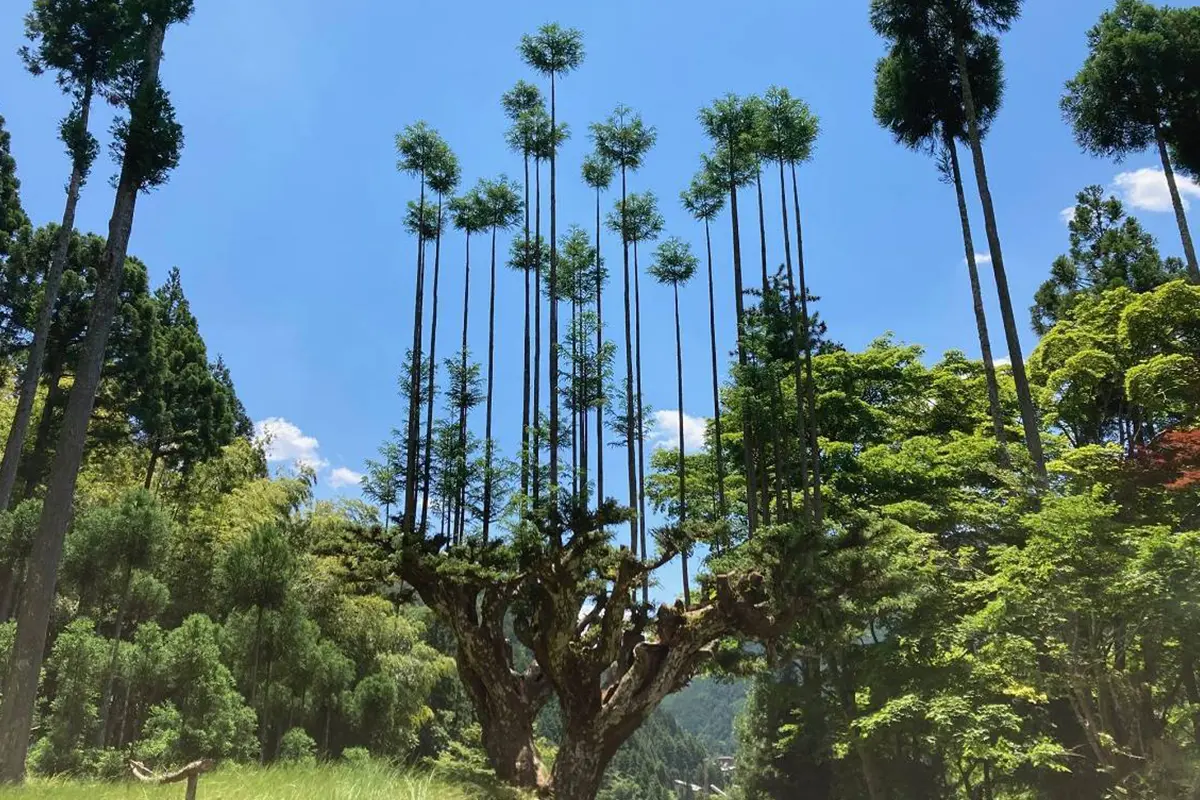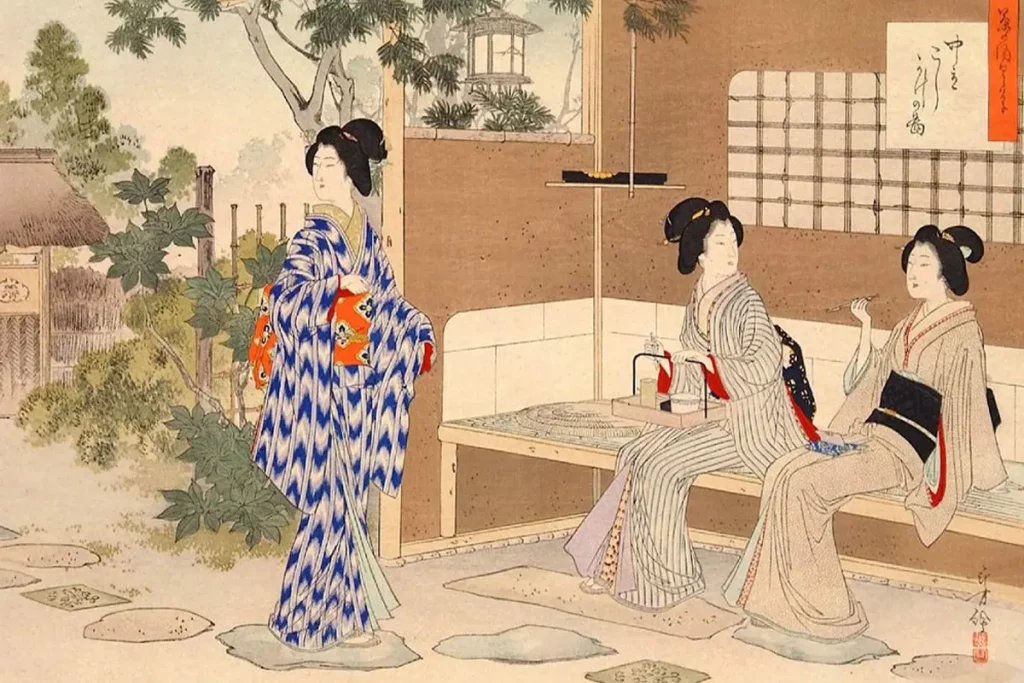The ancient Japanese art of pruning and harvesting, Daisugi, translated as platform cedar – it started in the 14th century, and it has being modernised since then
Daisugi – an entire forest growing on a single tree
Can we obtain lumber without cutting down trees? From the way our tropical forests are disappearing, the answer is no. But actually, it is possible, if you don’t kill the tree, so it can continue growing. This is the ancient technique of Daisugi, meaning ‘platform cedar’, in use in Japan’s Kyoto prefecture since the fourteenth century.
The world’s forests, which occupy more than 30% of the globe’s land surface, are a natural resource for both the environment and mankind. Assisting to conserve huge quantities of carbon, maintain natural equilibrium, purify water and air, and provide a living for people all over the world.
In thirty years the worldwide forest area shrank by 178 hectares: the size of Libya
Forests of the size of 30 soccer fields are being lost every minute due to the ever-expanding global forestry and logging business. Since 1990, the worldwide amount of primary forest has shrunk by more than 80 million hectares, reducing the net loss of forest area from a total of 7.8 million hectares per year in the 1990s to 4.7 million hectares per year between 2010 and 2020. Simply said, over the span of said thirty years, the worldwide forest area shrank by 178 hectares – roughly the size of Libya.
The Japanese Culture
Japan is seen by the entire globe as a place where many specific Japanese characteristics still exist. If we allow their roots to go, Japan’s influence on the rest of the world will soon disappear as well.
If this perseveres, not only will those who are dependent on the forests for their livelihood lose their jobs, but the biodiversity that forests help to preserve would also disappear, making the notion of clearing them all out seem ludicrous. A number of ideas have been put out to keep forests safe, one of which is Daisugi that seeks to create an effective and sustainable method of forestry.
The creation of Daisugi forests required not only the kind of meticulous artistry that requires years to get perfect, but also, more pragmatically, a lot of wood. Our continuing need for wood is not an emerging dilemma.
In fact, Japan’s preference for wooden constructions forced them to deal with it starting as early as the 14th century, at the city of Kitayama, 20 kilometers northwest of Kyoto. According to legend, Sen-No-Rikyu, Kyoto’s foremost tea master, sought excellence from the Kitayama wood, which eventually led to the creation of the Daisugi technique.
Origins of the Daisugi in Japan and in Europe
In Kyoto, Japan, a mountainous, steep environment where it is difficult to cultivate and grow trees, there was an inadequate supply of timber for use in manufacturing and building homes. Due to an absence of natural resources, the locals developed a novel approach that was almost entirely influenced by bonsai pruning techniques.
The Daisugi and the sustainable forestry
The Daisugi method, offers fresh inspiration for safeguarding trees and fulfilling the high market demand for wood, emerged as a solution in a world driven by deforestation and the race to achieve low-cost productivity and efficiency.
This ancient method, well-known in Japan, also has origins in ancient Rome, where it was known as pollarding, as well as in Europe as a whole, particularly in Britain, where it was also known as coppicing.
A single tree can provide dozens or even hundreds of trunks
Beyond allowing for an improvement in the durability and value of timber gathered per hectare, the Daisugi technique also allows for the creation of a full forest system in a single tree, which speeds up the growth cycle and increases the amount of timber produced.
A method that is best characterized as using already-existing trees to grow new ones. An open palm-like structure with vertical trees sprouting from it is the end result of this technique, which also prevents the mother tree from being cut down, allowing for a sustainable harvest of wood from a single tree.
A single tree can provide dozens or even hundreds of trunks when cut down every twenty years or more.
For 200 to 300 years, a Daisugi produces timber before losing output
According to the legend, the original cedar to exhibit this mutation is still alive in Kitayama, centuries after it was born, where it is known by the name Shirosugi. The term Daisugi translates as ‘platform cedar’ or ‘platform of cedar’. For 200 to 300 years, a Daisugi produces timber before losing output, despite this, a few trees have grown to be fifteen meters in diameter at the base.
At a time when Kitayama cedar, a kind of straight and knot-free lumber, was in popular demand, daisugi was created as a reaction to an absence of seedlings and land to cultivate trees. Due to this issue, the indigenous horticultural method referred to as Daisugi was developed, allowing arborists to decrease the number of plants, speed up the harvest process, and produce relatively denser wood.
What is known as the ‘platform cedar’
The Kitayama cedar should ideally be pruned so that the remaining shoots grow straight up from a platform. This produces the round, straight wood known as taruki, which is primarily utilized in the roofs of Japanese teahouses.
These shoots are then carefully watched over the following few years and encouraged to grow vertically using a system of bamboo poles and ropes. Every two years, the shoots are methodically hand-pruned, removing all except the top boughs to allow for straight growth.
Daisugi cedar can be harvested every 20 years, and since the root tree can live for hundreds of years, there is a substantial amount of wood that can be obtained from a single tree. In light of the fact that we need trees to absorb our emissions, supply oxygen, and support wildlife biodiversity, it is a quicker technique than others for saving the world’s forestry business.
Japan’s Daisugi technique is a clever approach to grow more wood on less area
With reference to claims, the lumber made using this technology is 200% more dense and robust and has 140% more flexibility than regular cedar, making it the perfect material for rafters and roof timber.
This method makes it possible for foresters to harvest wood much more quickly, and the shoots can either be gathered or planted to help swiftly populate a forest. If done correctly, it can also aid in preventing deforestation. Following that, the majority of the Taruki wood was employed in the construction of Kyoto’s traditional Japanese teahouses.
Given that the world’s forests are a natural resource of virtually unmatched relevance, Japan’s Daisugi technique is a clever approach to grow more wood on less area while also preserving the trees’ capacity to absorb and store carbon, lessening the consequences of global warming as a whole.
The ultimate result is a thin, flexible, and dense cedar, which is perfect for conventional wood roofs and beams. Even 600 years later, people still favor the straight, slim, and typhoon-resistant final product of Daisugi.
Modernizing an ancient practice – the challenges
Despite its reputation for toughness, Kitayama sugi is still a softwood and is not the best choice for use in load-bearing structures. But because just the upper branches are harvested and the remainder of the tree is left alone, it is in line with the principles of environmental conservation.
For western timber firms in particular, it is understandable to suggest that this would simply be something new, strange, and unconventional. Most industries around the world, including the timber industry, are not yet prepared to comply with the environmental needs of our planet.
Updating outdated techniques to satisfy new requirements
Daisugi has a lot to offer, but it also has a lot of drawbacks. The obligation to update outdated techniques in order to satisfy new requirements is one of the largest challenges. We have all been impressed by the grace of traditional Japanese architectural designs and their deft use of wood. They needed the kind of devoted artistry that takes centuries to create, and we could pick up a few tips from our daily lives to satisfy the public’s need.
In a world dominated by deforestation and the race to achieve low-cost productivity and efficiency, where ancient traditions and manual handcrafting skills are being lost, it would be appealing to go back to studying this ancient Japanese technique, which could offer new inspiration for preserving our trees, a common asset of inestimable value
Daisugi
Daisugi is a Japanese forestry technique that originated in Kyoto around the 14th century. Shoots from a type of cedar tree are carefully pruned so that multiple branches grow straight up from the base of the tree. This ancient tradition allows beautiful, straight logs to be harvested from the tree without having to cut it down at the base, which makes it a very sustainable forestry technique. The harvested logs are often used to build traditional tea houses.




















